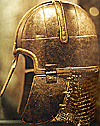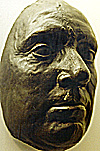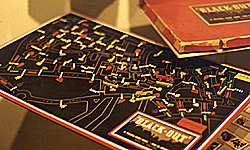The Coppergate Helm

 Conservators from the York Archeological Trust and the British Museum deserve the credit for preserving the helm, adding the small bits and pieces of replacement parts, and generally making the helm a prized item. The nasal bar of dragons contains a slight nick, perhaps a sword or dagger cut? And there's a small dent on one side of the helm.
Conservators from the York Archeological Trust and the British Museum deserve the credit for preserving the helm, adding the small bits and pieces of replacement parts, and generally making the helm a prized item. The nasal bar of dragons contains a slight nick, perhaps a sword or dagger cut? And there's a small dent on one side of the helm.
It is not a Viking helm but an Anglo-Saxon one made between 775 and 800 AD. Close enough--speculation is that it was lost as a result of a Viking attack circa 866. It is made of iron and brass with crossed ridges, cheek plates, and a nose piece.
 It contains an inscription:
It contains an inscription:
-
IN NOMINE DNI NOSTRI IHVSCS SPS DI ET OMNIBUS DECEMUS AMEN OSHERE XPI
Large Versions of Helm Photos (extremely slow: 406K)
Now, here is where two slightly different versions of where it was found exist. In the Jorvik Viking Centre, the helm was supposedly found in a wood lined pit in a field. In the York Castle Museum, the text says it was found in a well. It is probably the same thing--the well was woodlined and it was in a field. But it is not clear to me.
In any case, I go with the well scenario, for there wasn't a suit of armor or other items of gear in evidence (at least not in the text), which means if you were burying something of value like a helm, you'd probably bury other gear of value too. My completely unsubstantiated guess is that the warrior who owned the helm was running from a lost battle in which a sword cut came awfully close to taking off the top of his head, or even the tip of the sword caught the nasal guard, but the rest of the sword sliced his face.
He ran and figured to ditch the helm so either he would not be recognized as a fighter or he didn't want the Vikings to get their hands on his helm. Maybe he figured to retrieve it later.
The dent may have been a whack to the side of the head from a shield, rather than what happens when you throw a perfectly good helm in a well. You'd think a helm would be able to absorb a toss, unless it was a violent throw, in a well. Or, the Anglo-Saxon warrior was whacked on the head and partially stunned, then sliced in the face, and figured he had enough of this battle bit.
More Armor
Upstairs you enter the Great Yorkshire Battles Gallery. It turns out to be quite an extensive collection, certainly not as large as the British, French or Belgian Army Museums, but quite well done. Don't forget to turn around as you ascend the stairway--quite a neat display on the wall of the stairwell.
In roughly the order in which you see them, the Napoleonic wars are up first with a display of weaponry, including Brown Bess, French Light Infantry musket, and a Baker Rifle. There are also a variety of papers and illustrations, as well as a French 8th Regiment badge and Garde Imperiale Chasseur papers.
There is a very interesting Nock Volley Gun--a seven-barrelled gun for use on naval ships in order to shoot snipers prior to boarding. Somehow, that description does not seem quite right. It does not look particularly accurate with such short barrels. I would think it was more like a shotgun used to repel borders before drawing steel. And it seems a one-shot weapon because it must have taken a considerable time to reload.
 A display case of 30 Years War armor (at right) brings an eerie blueness in an equally dark battle scene--quite moody and virtually impossible to photograph.
A display case of 30 Years War armor (at right) brings an eerie blueness in an equally dark battle scene--quite moody and virtually impossible to photograph.
 As for the English Civil War, a display case shows the Battle of Aldwalton Moor, 30 June 1643. There are swords galore, bill hooks, helmets, and other well, arms and armour, but no mannikins. It is a display of the arms and armor, not of a battle scene. In the battle, so the text reads, 10,000 Royaltists fought 4000 Parliamentarians and 4000 militia. The Royalists won.
As for the English Civil War, a display case shows the Battle of Aldwalton Moor, 30 June 1643. There are swords galore, bill hooks, helmets, and other well, arms and armour, but no mannikins. It is a display of the arms and armor, not of a battle scene. In the battle, so the text reads, 10,000 Royaltists fought 4000 Parliamentarians and 4000 militia. The Royalists won.
Other artifacts from the time period include Selby helmets and Cromwell's Death Mask (at left).
WWII Home Front
An exhibit traces York during WWII, of course concentrating on home front activities. A considerable number of uniforms are displayed from a variety of sources, including a number of women's uniforms, medals, and armament.
York was bombed by the Luftwaffe on 28-29 April, 1940. The exhibit includes the German attack plan outlining the railroad, infantry barracks, and factory targets.

 For the kids, there is Black Out--a board game combining cards and markers. On the corners of the board are Charing Cross, Holborn, and Hyde Park (sorry, couldn't read the fourth). Symbols and a street map layout of London evidently govern play, although the exact rules were not displayed.
For the kids, there is Black Out--a board game combining cards and markers. On the corners of the board are Charing Cross, Holborn, and Hyde Park (sorry, couldn't read the fourth). Symbols and a street map layout of London evidently govern play, although the exact rules were not displayed.
As time was short, we barely saw the last few exhibit galleries. A Costume gallery displayed gowns and accessories from the 1830s-40s on up, a few uniforms like the local militia 1810 (at left), and then gave way to a Children's Gallery filled with toys.
The gift shop is the last stop, though sadly, we were already past the time to close the museum and shuffled out into the evening.
Must See
The York Castle Museum is an absolute must-see stop whenever you are in York. It has a little of everything for everybody. Just make sure you leave plenty of time to see that "everything."
York Castle Museum Information
-
York Castle Museum
The Eye of York
York YO1 1RY
tel: 1904 653 611 (general inquiries)
tel: 345 660 280 (information line)
web: www.york.gov.uk
Admission:
No hours listed, but closes at 6:00p.m. Presumably opens at 9:00 a.m. or 10 a.m.
- Adults: About £ 5
More York
-
York Introduction
Jorvik Viking Centre
Castle Museum (part 1)
Castle Museum (part 2)
Walk Around York (part 1)
Walk Around York (part 2)
Map of York (Large: 152K)
Back to List of Historical Sites
Back to Travel Master List
Back to MagWeb Master List of Magazines
© Copyright 1998 by Coalition Web, Inc.
This article appears in MagWeb (Magazine Web) on the Internet World Wide Web.
Other military history articles and gaming articles are available at http://www.magweb.com